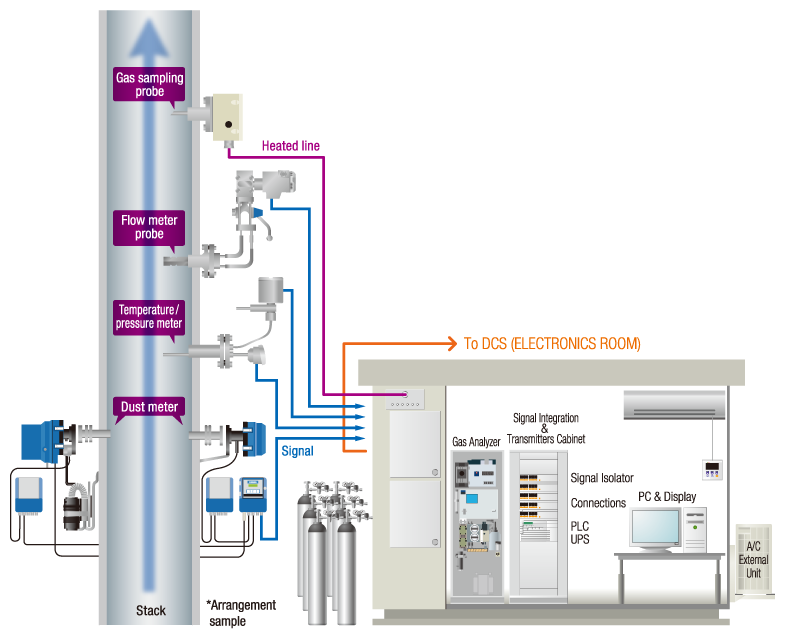CEMS KLHK – In making a smart city and also with a guarantee where air pollution can be well maintained, it is necessary to have a CEMS or Continuous Emission Monitoring System which is a continuous emission monitoring system. Building a smart city must indeed require the help of technology and good information. Technological developments can indeed be very useful in making the environment better and maintained.
CEMS with cutting edge technology is very important for real-time monitoring and monitoring of the stack, to consider the emissions can be strictly controlled according to the permitted emission standards.
Table of Contents
KLHK (Ministry of Environment and Forestry)
This CEMS is a regulation made by KLHK. CEMS KLHK is a breakthrough that is very appropriate how you can still feel the fresh air even though there are now many industrial factories that emit gas emissions. Of course this is very important for the survival of living things.
CEMS is a very important system for monitoring the gas emissions that are wasted in industries that emit gases every day.
KLHK is
We’ve been discussing about CEMS KLHK earlier. What exactly is KLHK? The Ministry of Environment and Forestry (KLHK) is the ministry responsible for managing and conserving all forest areas in Indonesia.
For additional information, KLHK has 2 Research Centers in the PUSPIPTEK Area which were established on August 12, 1993. The Center for Quality Research and Development and Environmental Laboratory (P3KL) functions as environmental monitoring, and the Center for Community Development and Environmental Generation functions as an Education and Training Institute.
A Brief History of KLHK
The Ministry of Environment and Forestry is the result of the merger of the Ministry of Environment and the Ministry of Forestry. This merger was carried out during the leadership of President Jokowi.
The history of the formation of the Ministry of Environment and Forestry is quite long, having changed its name until now to the Ministry of the Environment.
History of the formation of the Ministry of Environment:
- 1978-1983: State Ministry of Development and Environment Supervision
- 1983-1993: State Ministry of Population and Environment
- 1993-2005: State Ministry of Environment
- 2005-2014: Ministry of Environment
And the history of the Ministry of Forestry is as follows:
- 1983: Ministry of Agriculture
- 1983-1998: Ministry of Forestry
- 1998: Ministry of Forestry and Plantations
- 1998-2005: Ministry of Forestry
- 2005-2014: Ministry of Forestry
And in the end in 2014 it was merged into KLHK, which stands for the Ministry of Environment and Forestry.
Industry Required CEMS
The most important environmental monitoring is air quality monitoring is a consequence for companies and activities that emit air pollutants. Air quality monitoring includes emission air and ambient air, which is required for compliance with regulations (routine monitoring-abnormal-emergency, AMDAL/UKL-UPL, PROPER, etc.) and predicting the effect of air emission pollution on the environment. In terms of sampling and measurement, the role of the Government Environment Lab (DLH, KLH, etc.) and the private sector is very important.
The MoEF CEMS has very specific objectives of air quality monitoring which include:
- Quality standard compliance data
- Evaluation of the performance of air pollution control devices
- Process control
- Proof in legal process
- Research, etc.
Minister of Environment and Forestry Regulation Number 13 of 1995
Actually, the industry that is obliged to CEMS is regulated in the Minister of Environment and Forestry Regulation number 13 of 1995.
Companies/activities that are supposed to carry out manual monitoring within the time period stipulated by the applicable law. In addition, according to the Decree of the Minister of the Environment Number 13 of 1995.
There are 4 kinds of industries that must monitor using CEMS (Continuous Emission Monitoring System) namely: Iron and Steel Industry, Pulp and Paper Industry, Coal-Based Power Plant (PLTU), and Cement Industry. CEMS and manual monitoring are also required for Thermal Power plants with capacities above 25 MW (Minister of Environment Law No. 15 of 2019).
CEMS Explanation
We’ve been talking about CEMS for a long time. CEMS KLHK indeed, you should be able to enjoy fresh air by monitoring gas emissions using CEMS. So, the gas emissions that are wasted in this industry can certainly be monitored with certainty.
The results of monitoring like this can be applied to see compliance between the company’s air quality management performance with applicable regulations and to measure the performance of air pollution control programs, so that follow-up and corrections that need to be done by the company can be arranged. For this reason, Human Resources (HR) are needed who have the understanding and ability to manage and monitor air quality in companies as well as Government and Private Environmental Laboratories.
CEMS Is
For starters, CEMS is an equipment analyzer used to monitor and measure the amount of pollutants emitted by industrial chimneys into the air. Pollutants that are often monitored are SO2, NOx and NO2, CO, CO2, H2S and NH3, HCl, HF, THC, Mercury.
Continuous emission monitoring systems can be required for a number of reasons for stationary source monitoring.
What Are the Features of CEMS?
CEMS is a gas analyzer in a continuous emission monitoring system can use one of a variety of detection technologies, such as:
- Fourier Transform Infrared (FTIR) spectroscopy measures a relatively wide range of infrared emission sources. It is useful for the analysis of various gases. Non-Dispersive Infrared (NDIR) spectroscopy does not change the wavelength of infrared light entering the sampling chamber.
- Chemiluminescence is often used to measure nitrogen oxides and detect the intensity of light produced by nitric oxide and ozone reactions.
- Pulsed fluorescence is often used to measure SO2. This involves exposing the gas to ultraviolet radiation and measuring the resulting fluorescence emitted when the gas absorbs UV light. Atomic fluorescence spectroscopy is also used to measure mercury emission.
- Flame Ionization Detection (FID) involves the analysis of the ions produced during the combustion of emissions in a hydrogen flame.
CEMS KLHK
CEMS is regulated by the Ministry of Environment and Forestry in order to create a healthy air environment. Because it is known that this emission gas can pollute the air and cause the atmospheric ozone layer to become thinner and make the weather hotter and the climate uncertain.
The LHK Ministerial Regulation 15/2019 requires installation for generating capacity of more than or equal to 25 megawatts, or less than 25 megawatts with a sulfur content in the fuel of more than two percent.
CEMS Portal
CEMS Portal is a portal for monitoring CEMS in use. There, you can control gas emissions according to existing regulations. The CEMS portal is very helpful in various matters relating to gas emissions determined by the Ministry of Environment and Forestry.
SIMPLE KLHK
SIMPEL KLHK is the Electronic Licensing Reporting System for the Environmental Sector for Business and/or Activities (SIMPEL) is an online reporting application that replaces print reporting that has so far been sent to the Ministry of Environment and Forestry. With SIMPEL, companies no longer need to send hardcopy reports, just report online with a supporting file attachment.
KLHK tutorial
To be able to register with SIMPEL KLHK, the method is still quite easy. As long as the data you have prepared already exists, you can register.
1. The license holder fills out the SIMPEL registration form via the address http://simpel.menlhk.go.id and then sends it to the Cara Administrator.
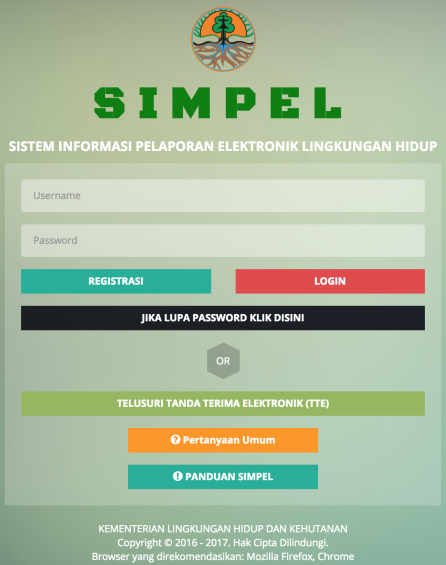
2. On the start page, click Register to register.
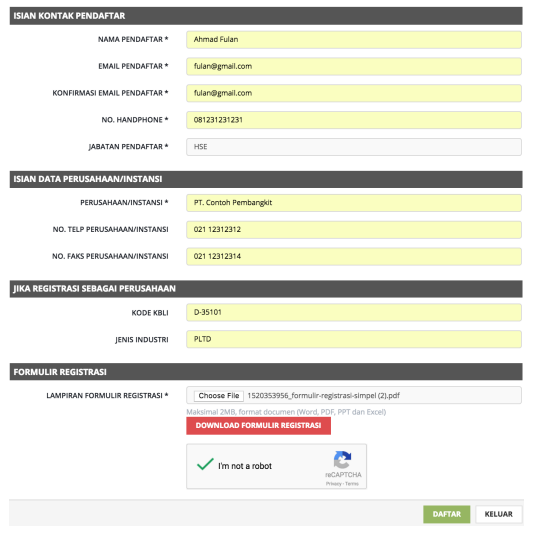
3. Fill in the data correctly in all fields on the form. In the Registration Form Attachment column, click Browse/Select File to upload a scanned SIMPEL registration application form.

4. The registration form in question can be viewed or downloaded by clicking Download Registration Form.
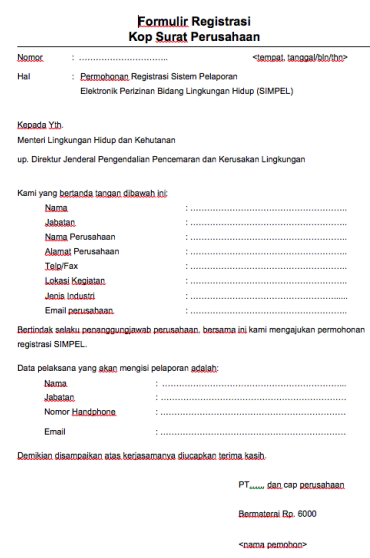
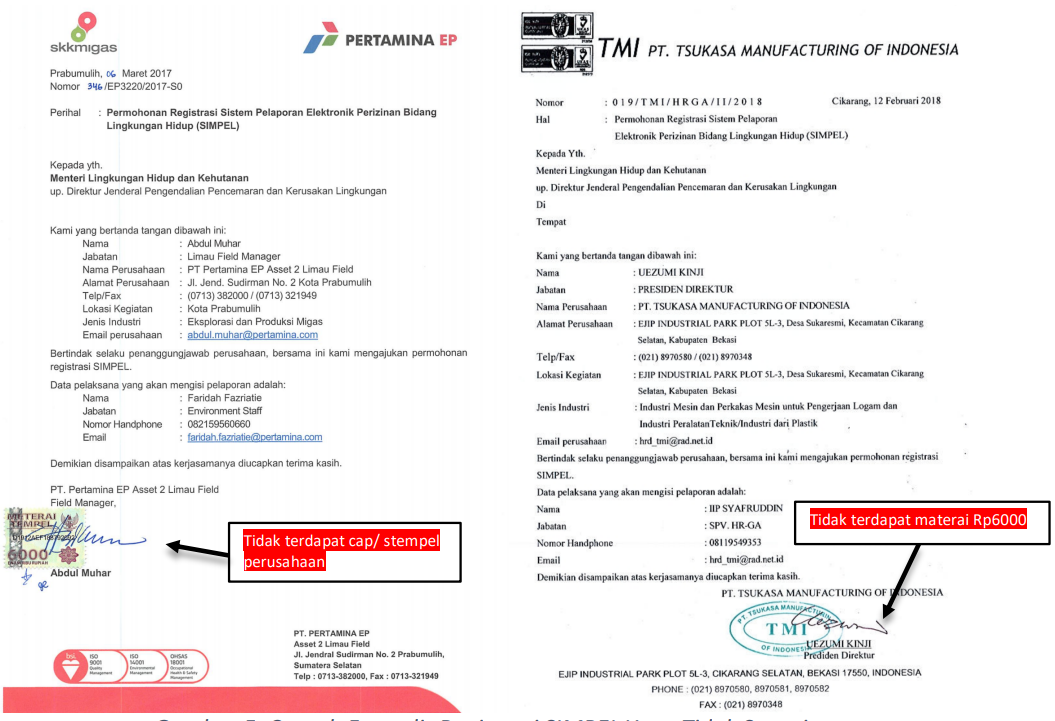
5. Check the box I’m not a robot.

6. Click Register when you are sure everything is done.
KLHK’s perspective
This is a work order for the provisions of Article 203 paragraph (6) of Government Regulations Number 22 of 2021 regarding the Implementation of Environmental Protection and Management, each person in charge of a business and/or activity that carries out monitoring automatically and continuously needs to integrate its emission monitoring into the in the industrial emission monitoring information system continuously.
MECHANISM AND STAGES OF SISPEK INTEGRATION
The person in charge of the business and/or activity carries out online registration via the https://ditppu.menlhk.go.id site accompanied by a letter of application for integration to the Director General.
This integration application letter contains data:
- Chimney code
- Emission source
- CEMS brand
- CEMS Type
- Parameter
SISPEK Integration Flowchart
The SISPEK integration flowchart is as follows:
These steps must be carried out in sequence and also for each stage must be completed before moving on to the next stage.
Explanation of the Mechanism and Stages of SISPEK Integration
The complete SISPEK registration mechanism and stages are as follows:
1. Registration
Online registration via the site https://ditppu.menlhk.go.id
2. Registration Validation
The Director General conducts online validation. There are two validation results:
- Correct and complete, the Director General issues a registration number; or
- Incorrect and incomplete, the Director General issues a letter of proof of incompleteness of the document.
3. Administrative Data
After getting the registration number, the next step is to complete the administrative data. This filling is also done online. This data includes:
- Company profile;
- Chimney attachment point; and
- Emission Source.
4. Technical Data
This technical data includes:
- Reference, including data on brands and equipment providers;
- Profile, covering the number of installed emission sources and the person in charge;
- Specifications, covering measurement and certification methods;
- Analyzer, covering parameters, measuring range and sample flow rate;
- Communication, covering network systems and DIS;
- Calibration, covering parameters and results; and
- Supporting data, including quality control and quality assurance documents.
5. Field Verification
The Director General after that carried out field verification. It could be directly or indirectly. And the decisions that will come out are two:
- Fulfilling the requirements, the Director General issues a notification of connectivity test scheduling accompanied by an authentication code; or
- Not meeting the requirements, the Director General issues a notification to follow up on the verification results
6. Connectivity Test
Connectivity test includes:
- Implementation of a trial run of CEMS data transfer from the DIS responsible for the business and/or activity to the SISPEK server; and
- Data transfer and communication apply the form of Java Script Object Notation and Application Programming Interface
In terms of connectivity test results say:
- Passed, the Director General issues a letter of approval; or
- Failed to pass, the person in charge of the business and/or busyness applies for re-registration.
The approval letter is issued no later than 7 (seven) working days after the connectivity test is declared to have passed.
The results of the connectivity test are compiled in the form of a report.
7. Approval letter
This approval letter will be issued and valid for 3 years and can be extended. This extension letter is submitted by the applicant to the Director General no later than 60 (sixty) calendar days prior to the expiration of the approval period.
Conclusion
That was how we discussed CEMS KLHK. If you are still confused about where you can get quality CEMS and also with a variety of interesting features, please contact NetData which provides quality CEMS. Contact NetData for more information.
![]()

